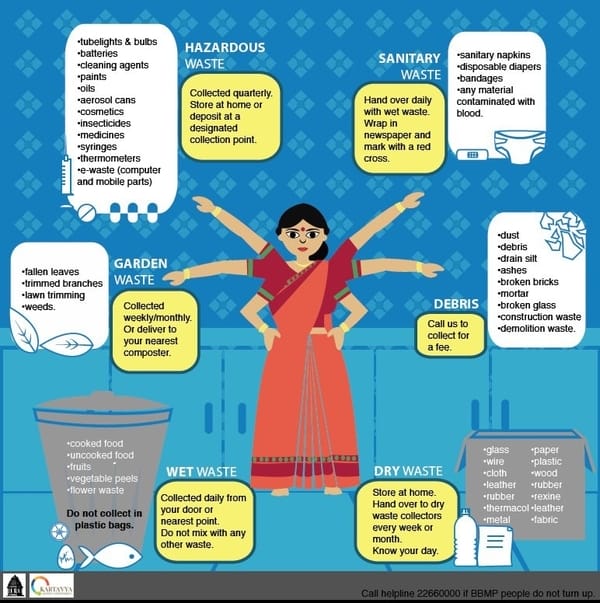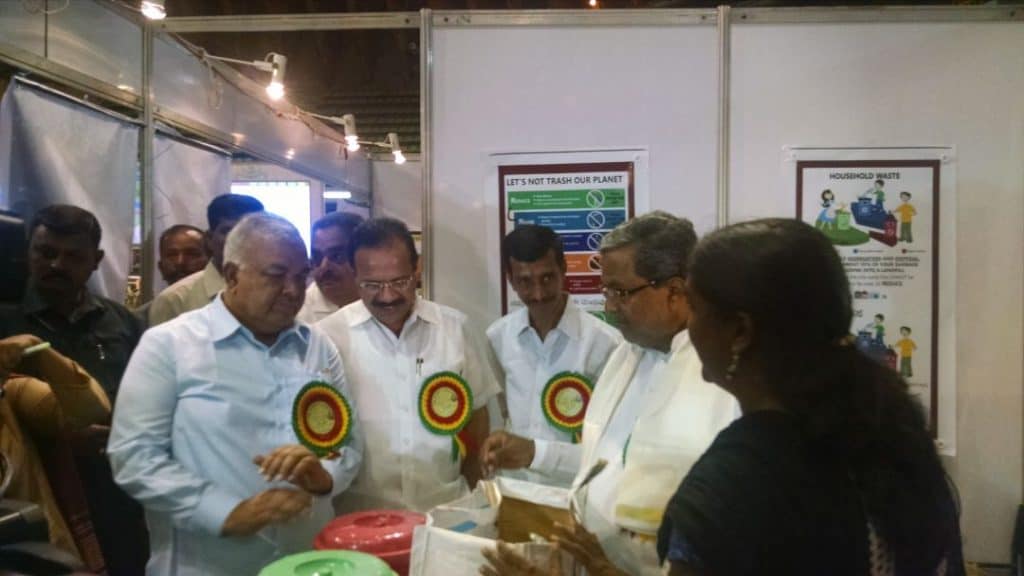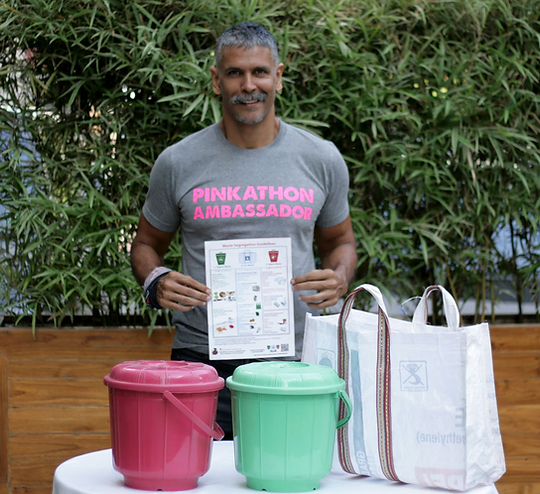Until a few years ago, Bengaluru used to dump all of its waste in landfills outside the city. While villagers living around the landfills faced serious health conditions, there was garbage dumped and burnt within the city as well, affecting the health of its residents. But now, the majority of the waste from residential households is getting segregated and processed. The 2Bin1Bag initiative was key to popularising waste segregation in Bengaluru households, especially in apartments.
2Bin1Bag showed that all that households had to do was segregate waste into three categories – wet waste in a green bin, reject/sanitary waste in a red bin, and all recyclables in a plastic bag.
The campaign was initiated by Kasa Muktha Bellandur (KMB) – a collective of waste volunteers in Bellandur, and championed by the citizen collective Solid Waste Management Round Table (SWMRT). “Over half the wards have an established waste management system now,” says Sandya Narayanan of SWMRT.
How did the campaign get such impressive results within a decade, that too in a city of over a crore people? Here’s the story.
Segregation existed, but wasn’t effective
In the late 2000s, many Bengalureans got together to solve the city’s waste problem. While the BBMP didn’t require residents to segregate waste, SWMRT started promoting segregation.

Malini Parmar of KMB says, “At the time, only ITC Ltd was collecting segregated waste from apartments, so that model was based on what ITC needed. Dry waste was collected in four categories – paper, plastic, metal and glass. Wet and sanitary waste were mostly kept together and taken by BBMP vendors to the landfill.”
Due to SWMRT’s efforts, quite a few apartment complexes had innovated their own models for segregation at the time. For example, Malini helped launch a seven-way segregation model in her apartment complex Springfields Apartments in Bellandur in 2011. In 2012, BBMP proposed eight-way segregation, says Malini.
But segregation into several categories was too complex, and most citizens did not keep up. However, citizens did have the intent to segregate, says Malini. In her own apartment, a year after segregation was introduced, 70% households were complying even though it was not mandatory. “So we realised that people do want to do it and they do care, as long as somebody else has thought through things,” says Malini.
Read more: Waste management best practices: Apartment residents set example
Like Malini, quite a few apartment residents in Bellandur, mostly women, who were perturbed by poor waste management, soon got together to form KMB, an informal collective.
Figuring out the problem
The team asked one of its members Lalitha Mondreti to study why many apartments across the city were not using the composting machines the builder had provided them.
Lalitha visited around 30 apartments in the city, and found that residents found segregation too difficult; they were not separating wet waste as is needed for composting. “Residents said they had no time, the children or elderly at home could not segregate, domestic workers kept changing, or housekeeping staff didn’t know how to handle it, etc.”
Each of these apartments was segregating waste in a different way, and KMB felt the need for a simpler model. “We found that globally there are colour codes for waste. First we used blue bins with labels on them such as paper, plastic, etc., then we realised that domestic workers may not understand it. So we put labels in Kannada,” Malini says. “But then somebody would say their domestic help knows only Tamil or can’t read at all. So we felt colour coding is more universal, then you don’t need to put stickers at all.”
Even children and the elderly could easily follow the colour coding, domestic workers working across different apartments faced no confusion as the kit is standardised, and the job of the housekeeping staff became easy.

Why 2Bin1Bag?
The goal was to increase the quantity of recyclables and compostable waste, and to reduce the reject waste that had to go to landfills. The team adopted green-coloured bins for wet waste and red ones for reject waste. For recyclables, which had to be clean and dry, they chose a large white plastic bag — since people intuitively would not use it as a trash bin and would ensure the papers, plastic, and metal items were clean and dry.
The entire set along with an information pamphlet was packaged into a kit. The team approached a vendor who was ready to supply it at Rs 100 each.
Read more: You can do this too: Clean city for just 100 bucks!
The model was first implemented in Lalitha’s 44-unit apartment Ozone Residenza in Bellandur, and was an instant success. Lalitha bought the kits and distributed them to the households. “Within two days, we had 99% segregation. The first couple of days I went around to each household and informed them if they made any mistakes. We also trained the supervisor and housekeeping staff, and gave them the same colour-coded bins and dry-waste bag for collection.” The same model was soon replicated in other apartments.
The model further evolved based on discussions among KMB members, inputs from the waste collection vendor Hasiru Dala, and feedback from apartment residents. Much thought went into what materials should go into which bin (for example, it was decided that coconut husk should go into dry waste rather than wet waste since it isn’t easily compostable) and how certain categories of waste like e-waste should be handled.
The model continues to evolve; for example, now there are updates on how to handle COVID waste, says Malini.
But segregation was only part of the problem. Even if residents segregated the waste properly, each category of waste needed a destination, and waste collectors also had to take it there. But the BBMP or private vendors who picked waste from apartments at the time paid no heed to segregation, and mixed up even the segregated waste.
Where would the segregated waste go?
Fed up with the vendors, many KMB volunteers approached Nalini Shekar, co-founder of the NGO Hasiru Dala which was then trying to support waste collectors. Hasiru Dala agreed to collect the waste, and devised a fee collection system.
They charged Rs 2 per kilogram of wet waste or dry waste. But for reject waste, the charge was Rs 3 per kg. “The people who didn’t want to segregate would put all of their waste in the reject bin. The apartments did pay, but we went back and told them it was not right. We told the associations that their costs would reduce if they segregated better and gave only reject waste in the red bin,” says Nalini.
She says that the differential pricing, along with the workshops that Hasiru Dala held with apartment residents and domestic workers, led to a huge success. “With these, the amount of reject waste per household reduced from 310 gram per day to 105 gram.”

Listen: Podcast: How citizen activists are trying to solve Bengaluru’s garbage problem
Convincing residents about the 2Bin1Bag model
Waste volunteers from more apartments replicated the model in their apartments over time.
Lalitha says it took tremendous effort to convince associations to take up segregation in the first 2-3 years: “I would randomly walk into any apartment in Bellandur, just talk to the manager and get the contacts of the apartment association, and then get the association in a meeting and explain the concept to them. If you spoke to 10 associations in a week, at least one would agree. Like that, within six months, we converted 25 apartments, that is, more than 5,000 households.”
She adds that their success was because of the ability to provide end-to-end solutions. “If you are offering people a solution, you have to be sure that it’s going to work. And we had done a lot of background work to arrive at the solution. Many people were willing when they see there is a clear process in place.”
But, while the 2Bin1Bag kit itself cost only Rs 100 per household, the apartments’ costs would increase as Hasiru Dala was collecting and processing the segregated waste. However, the group pointed out that other vendors were charging less only because they collected waste infrequently, mixed the segregated waste, and also burned it nearby.
Enforcing segregation was difficult in larger apartments as well. Archana Prasad Kashyap, who was with KMB and lived in Adarsh Palm Retreat, says it took 5-6 months to just put in place all the processes in the complex which had around 1000 units at the time. “And after that, a lot of monitoring was needed. Our volunteer team would go door to door with the housekeeping staff, convincing people,” says Archana. But now the complex has around 2,500 households and complete segregation.
Taking the campaign to a bigger stage
Around 2013, some core members of KMB became part of SWMRT as well. And SWMRT decided to push the 2Bin1Bag campaign using their higher visibility and social media presence. Sandya of SWMRT says, “If we saw any celebrity at the time, we would insist on taking a picture of them posing with the two bins and bag, and use it for promotion.”

An open-source model for 2Bin1Bag!
Archana also helped set up a website for the initiative, which had all the resources required for citizens to replicate the model in their households. There were also ready posters and communication material. KMB also came to an agreement with Big Basket to sell the 2Bin1Bag kit online.
The campaigners were now getting enquiries from residents across Bengaluru as well as other cities like Gurugram, Pune and Chennai. In the earlier days, KMB used to help set up the process in apartments who reached out to them, but now apartments used the resources available on the website to replicate the process by themselves.
Municipalities from Sikkim and UP connected informally with SWMRT to learn about the model, says Sandya. In Tatanagar in Jamshedpur, the model still works quite well.
Finally court orders, protection from garbage mafia
In 2015, SWMRT was able to get an order from the High Court, mandating the adoption of the 2Bin1Bag model in Bengaluru. The order came about after Sandya took the kit to the courtroom and explained the concept to the judges.
In a hearing of the same PIL, the Bellandur volunteers raised concerns about threats to them from the garbage mafia. As more apartments in Bellandur started segregating and hired Hasiru Dala as the garbage collection vendor, the previous contractors had been losing their clientele. Lalitha recollects instances when she had to make sure the Hasiru Dala team could collect and transport garbage without hassle. The team held meetings with the contractor to resolve the issue. And eventually “the court gave a verbal order to the BBMP Commissioner we should be protected, and not threatened or harmed,” says Lalitha.

Read more: High Court orders Bengaluru to ‘divide and conquer’ the garbage problem
The SWMRT PIL brought up a whole range of issues including corruption in BBMP’s garbage contracts and the lack of Dry Waste Collection Centres (DWCCs) in the wards. The 2Bin1Bag model was working in apartments, which were legally required to give their waste to private contractors (not BBMP). But it would work in individual households only if BBMP contractors collected the segregated waste properly and took the dry waste to DWCCs. Else they might only mix the waste and dump it.
With court orders and sustained citizen campaigns, the city now has more DWCCs, and a section of wards now has separate tenders for dry waste collection. In 120 wards, BBMP has also signed MoUs with Resource Organisations (NGOs like Hasiru Dala) to help waste pickers set up their dry-waste collection system. BBMP also has a Citizen Participation Programme (CPP) that works with volunteers to streamline waste management in their respective localities.
Challenges remain, especially in independent houses
While the 2Bin1Bag model is popular in apartments, the model is proving difficult to implement at the individual house level, says Sandya. “2Bin1Bag model was the only thing that led to apartments immediately achieving the required segregation levels. Apartments have a set process – the management committees buy the kits and distribute it to households. Those in individual houses may not know about the exact model, though they may know about three-way segregation,” she says.
Read more: How Bengaluru’s crumbling Dry Waste Collection Centres can be overhauled
HSR Layout and Yelahanka are the two wards in Bengaluru that have had a sustained volunteer system over the years that ensured segregation. Chitra Praneeth, who was part of the volunteer team that launched the 2Bin1Bag model in HSR Layout, says they have worked with residents, the garbage contractor, elected representatives, and BBMP officials over years to set up the model.
“Even now, residents in many other wards are following only two-way segregation, and when a new person starts living here we have to educate them.” Here the block and lane-level volunteers resolve problems related to waste collection, and also identify defaulters who will then be penalised by BBMP.
“It’s an ongoing, never-ending process,” says Sandya. But Bengaluru is now one of the top cities in India in terms of segregation, having achieved 60% segregation at one point, she says. The city’s gains over the past decade give her hope.
[Corrigendum: The description of Hasiru Dala has been changed from ‘garbage contractor’ to ‘garbage collection vendor’.]
This article is part of a series on Civic Change in Bengaluru.
Hi , This is a great initiative a good idea for waste management. Chennai citizens should also follow this 2 bin 1 bag idea for better waste management. During our recent Chennai visit observed wet and dry waste is not segregated by citizens. Waste segregation should start at home for better landfill and trash management.
Thank you for this comprehensive article on 2bin1bag. The simple concept has transformed the waste segregation situation in Bengaluru. It is simple to follow and implement even in large residential complexes.